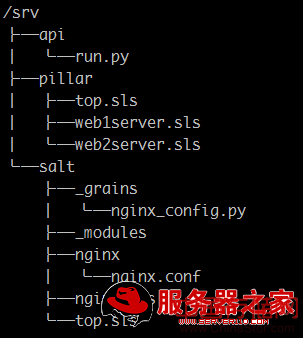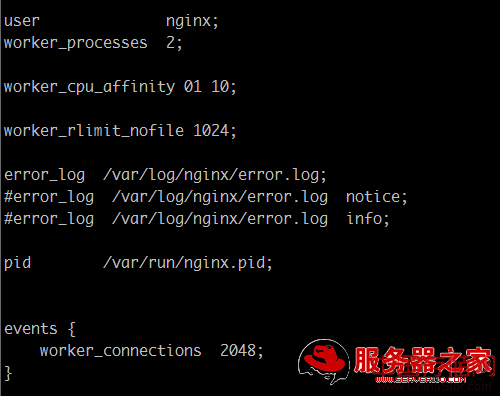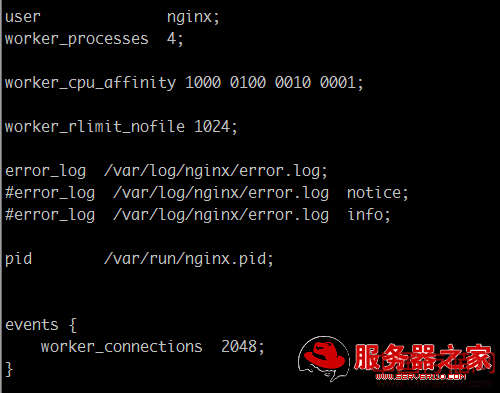本文介绍使用saltstack实现服务器批量自动化配置,希望对于初学Nginx服务器相关的朋友有帮助,更多Nginx安装、配置、报错处理等资源请本站内搜索。。
一、设备环境说明
有两组web业务服务器,组名分别为web1group与web2group,设备硬件配置、web根目录存在异常,见下图:

二、master配置说明
1、关键配置定义:
nodegroups:
web1group: [email protected],SN2012-07-011,SN2012-07-012'
web2group: [email protected],SN2013-08-022'
file_roots:
base:
- /srv/salt
pillar_roots:
base:
- /srv/pillar
2、定义的文件树结构(具体文件后续说明)

三、自定义grains_module
1)#vi /srv/salt/_grains/nginx_config.py
import os,sys,commands
def NginxGrains():
'''
return Nginx config grains value
'''
grains = {}
max_open_file=65536
#Worker_info={'cpus2':'01 10','cpus4':'1000 0100 0010 0001','cpus8':'10000000 01000000 00100000 00010000 00001000 00000100 00000010 00000001'}
try:
getulimit=commands.getstatusoutput('source /etc/profile;ulimit -n')
except Exception,e:
pass
if getulimit[0]==0:
max_open_file=int(getulimit[1])
grains['max_open_file'] = max_open_file
return grains
2)同步grains模块salt '*' saltutil.sync_all
3)刷新模块(让minion编译模块)
salt '*' sys.reload_modules
4)验证max_open_file key的value
[[email protected] _grains]# salt '*' grains.item max_open_file
SN2013-08-022:
max_open_file: 1024
SN2013-08-021:
max_open_file: 1024
SN2012-07-011:
max_open_file: 1024
SN2012-07-012:
max_open_file: 1024
SN2012-07-010:
max_open_file: 1024
四、配置pillar
本例使用分组规则定义pillar,即不同分组引用各自的sls属性
1)定义入口top.sls
#vi /srv/pillar/top.sls
base:
web1group:
- match: nodegroup
- web1server
web2group:
- match: nodegroup
- web2server
2)定义私有配置,本例只配置web_root的数据,当然可以根据不同需求进行定制,格式为python的字典形式,即"key:value"。#vi /srv/pillar/web1server.sls
nginx:
root: /www
#vi /srv/pillar/web2server.sls
nginx:
root: /data
3)验证配置结果:#salt 'SN2013-08-021' pillar.data nginx
SN2013-08-021:
----------
root:
/data
#salt 'SN2012-07-010' pillar.data nginx
SN2012-07-010:
----------
root:
/www
五、配置States
1)定义入口top.sls
#vi /srv/salt/top.sls
base:
'*':
- nginx
2)定义nginx配置及重启服务SLS,其中salt://nginx/nginx.conf为配置模板文件位置。#vi /srv/salt/nginx.sls
nginx:
pkg:
- installed
file.managed:
- source: salt://nginx/nginx.conf
- name: /etc/nginx/nginx.conf
- user: root
- group: root
- mode: 644
- template: jinja
service.running:
- enable: True
- reload: True
- watch:
- file: /etc/nginx/nginx.conf
- pkg: nginx
3)Nginx配置文件(引用jinja模板)功能点:
1、worker_processes参数采用grains['num_cpus'] 上报值(与设备CPU核数一致);
2、worker_cpu_affinity分配多核CPU根据当前设备核数进行匹配,分别为248其它核;
3、worker_rlimit_nofile参数与grains['max_open_file'] 获取的系统ulimit -n一致;
4、worker_connections 参数理论上为grains['max_open_file'];
5、 root参数为定制的pillar['nginx']['root']值。
#vi /srv/salt/nginx/nginx.conf
# For more information on configuration, see:
user nginx;
worker_processes {{ grains['num_cpus'] }};
{% if grains['num_cpus'] == 2 %}
worker_cpu_affinity 01 10;
{% elif grains['num_cpus'] == 4 %}
worker_cpu_affinity 1000 0100 0010 0001;
{% elif grains['num_cpus'] >= 8 %}
worker_cpu_affinity 00000001 00000010 00000100 00001000 00010000 00100000 01000000 10000000;
{% else %}
worker_cpu_affinity 1000 0100 0010 0001;
{% endif %}
worker_rlimit_nofile {{ grains['max_open_file'] }};
error_log /var/log/nginx/error.log;
#error_log /var/log/nginx/error.log notice;
#error_log /var/log/nginx/error.log info;
pid /var/run/nginx.pid;
events {
worker_connections {{ grains['max_open_file'] }};
}
http {
include /etc/nginx/mime.types;
default_type application/octet-stream;
log_format main '$remote_addr - $remote_user [$time_local] "$request" '
'$status $body_bytes_sent "$http_referer" '
'"$http_user_agent" "$http_x_forwarded_for"';
access_log /var/log/nginx/access.log main;
sendfile on;
#tcp_nopush on;
#keepalive_timeout 0;
keepalive_timeout 65;
#gzip on;
# Load config files from the /etc/nginx/conf.d directory
# The default server is in conf.d/default.conf
#include /etc/nginx/conf.d/*.conf;
server {
listen 80 default_server;
server_name _;
#charset koi8-r;
#access_log logs/host.access.log main;
location / {
root {{ pillar['nginx']['root'] }};
index index.html index.htm;
}
error_page 404 /404.html;
location = /404.html {
root /usr/share/nginx/html;
}
# redirect server error pages to the static page /50x.html
#
error_page 500 502 503 504 /50x.html;
location = /50x.html {
root /usr/share/nginx/html;
}
}
}
4)同步配置#salt '*' state.highstate

(由于非第一次运行,看不到配置文件比对的信息)
5)验证结果:
1、登[email protected]
#vi /etc/nginx/nginx.conf


2、登[email protected]
#vi /etc/nginx/nginx.conf


声明: 此文观点不代表本站立场;转载须要保留原文链接;版权疑问请联系我们。










